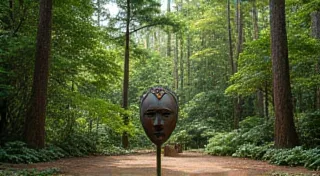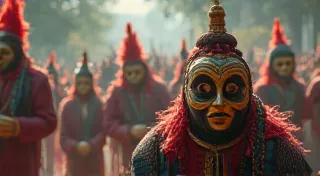Tibetan Opera Masks: Depicting Gods, Demons, and Heroes
Tibetan opera, known as lama ngorma, is a vibrant and integral part of Tibetan culture. Its performances are more than just entertainment; they’re a complex blend of religious teachings, historical narratives, and moral lessons, all brought to life through elaborate costumes, music, and, most importantly, striking masks. These masks, more than just covering faces, are powerful symbolic representations of the characters performing within the opera.
The Significance of Tibetan Opera Masks
The tradition of Tibetan opera masks dates back centuries, with strong influences from earlier Tibetan religious art and indigenous shamanic practices. Originally, masks were used in religious rituals aimed at warding off evil spirits and invoking blessings. Over time, these rituals evolved into the theatrical form of opera we know today, with the masks retaining their symbolic power. The very concept of utilizing masks to embody specific roles and intentions is a practice found across numerous cultures and artistic traditions, and the way Tibetan opera masks achieve this has fascinating parallels with traditions worldwide. Consider, for example, the role of masks in other performance art forms – exploring how the act of concealing and revealing identity contributes to the overall message and impact.
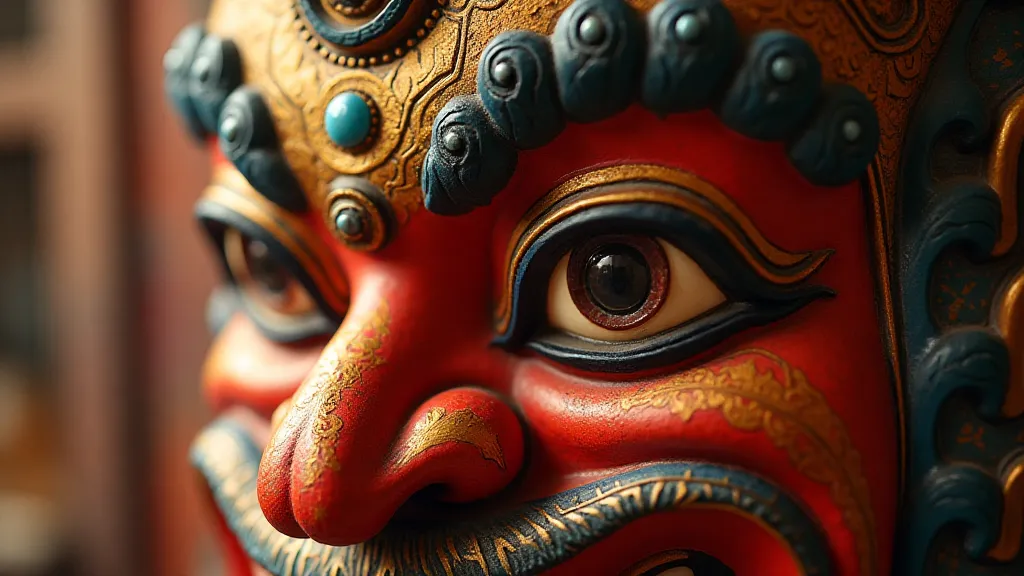
Character Types and Symbolism
The masks in Tibetan opera represent a wide range of characters, broadly categorized as gods, demons, heroes, and royalty. Each type carries specific symbolism:
Gods and Deities: Often depicted with serene expressions and adorned with jewels and precious materials, these masks represent benevolent forces and divine protectors. The colors used are typically bright and uplifting, such as gold, white, and red.
Demons and Monsters: These masks are often grotesque and fearsome, embodying chaos and negativity. Their purpose isn't merely to frighten but to represent the forces that must be overcome through enlightenment and virtue. Red, black, and green are common colors. The creation of these unsettling visages, intended to inspire both fear and a cathartic release, reflects a universal desire to confront and understand the darker aspects of human experience and the cosmos.
Heroes and Kings: These masks portray courageous figures, often embodying justice and strength. Their expressions are typically stoic and commanding.
Ngepa (Clowns): A unique and essential category, Ngepa masks are often characterized by exaggerated features and humorous expressions. They act as comic relief and often deliver social commentary. The way these masks utilize exaggerated features to elicit laughter and deliver subtle critiques demonstrates the power of humor as a tool for social commentary, a practice observed globally.
The materials used in mask making also contribute to their symbolic meaning. Traditional masks are often crafted from wood, sometimes covered with layers of cotton or paper and painted with natural pigments. The complexity of the design and the quality of the craftsmanship can also signify the character's status and importance within the opera. The intricate construction of these masks echoes practices found in other cultures, demonstrating how the act of creating and adorning oneself with symbolic representations is a core element of human expression. For instance, the use of masks as boundaries—in ritual and rebellion—is a recurring theme throughout human history, explored in detail in The Cartography of Fear: Masks as Boundaries in Ritual and Rebellion. They aren't mere coverings; they are potent symbols of identity, authority, and purpose.
The Craftsmanship Behind the Masks
Creating Tibetan opera masks is a highly skilled craft, often passed down through generations. The process typically involves several stages:
Carving the Base: The mask's form is painstakingly carved from a block of wood.
Adding Layers: Cotton or paper is applied to the carved wood to create a more rounded and expressive surface.
Painting and Decoration: The mask is then painted with vibrant colors and intricate designs, reflecting the character's personality and role. Details like eyes, teeth, and beards are meticulously rendered.
Embellishment: Finally, the mask is adorned with embellishments such as jewels, feathers, and metal ornaments.
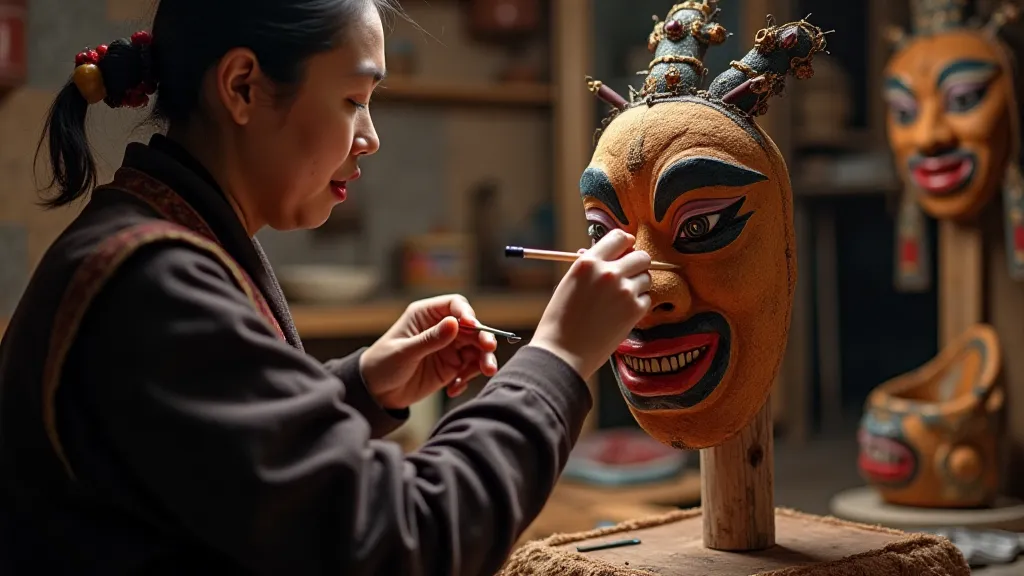 The process itself—from initial carving to final embellishment—is steeped in tradition and artistic expertise. This dedication to meticulous detail resonates with other masking traditions around the world. The masks of Kerala, India, for example, with their elaborate Kathakali and Theyyam traditions, represent another level of artistry. A deeper exploration of these traditions, and their cultural significance, can be found in The Masks of Kerala, India: Kathakali and Theyyam Traditions. The artisans involved are not merely craftspeople; they are custodians of cultural heritage, ensuring the continuity of these sacred practices.
Masks in Modern Tibetan Culture
Today, Tibetan opera continues to be an important part of Tibetan cultural identity. While the traditional forms are preserved, there are also contemporary interpretations and adaptations of the art form. The masks themselves remain powerful symbols, serving as a tangible link to the past and a vibrant expression of Tibetan cultural heritage. The ability of these masks to traverse generations, retaining their significance despite evolving social landscapes, is a testament to their enduring power. Their capacity to evoke strong emotional responses and to act as a visual shorthand for complex narratives underscores their essential role in the preservation and transmission of Tibetan culture.
The process itself—from initial carving to final embellishment—is steeped in tradition and artistic expertise. This dedication to meticulous detail resonates with other masking traditions around the world. The masks of Kerala, India, for example, with their elaborate Kathakali and Theyyam traditions, represent another level of artistry. A deeper exploration of these traditions, and their cultural significance, can be found in The Masks of Kerala, India: Kathakali and Theyyam Traditions. The artisans involved are not merely craftspeople; they are custodians of cultural heritage, ensuring the continuity of these sacred practices.
Masks in Modern Tibetan Culture
Today, Tibetan opera continues to be an important part of Tibetan cultural identity. While the traditional forms are preserved, there are also contemporary interpretations and adaptations of the art form. The masks themselves remain powerful symbols, serving as a tangible link to the past and a vibrant expression of Tibetan cultural heritage. The ability of these masks to traverse generations, retaining their significance despite evolving social landscapes, is a testament to their enduring power. Their capacity to evoke strong emotional responses and to act as a visual shorthand for complex narratives underscores their essential role in the preservation and transmission of Tibetan culture.
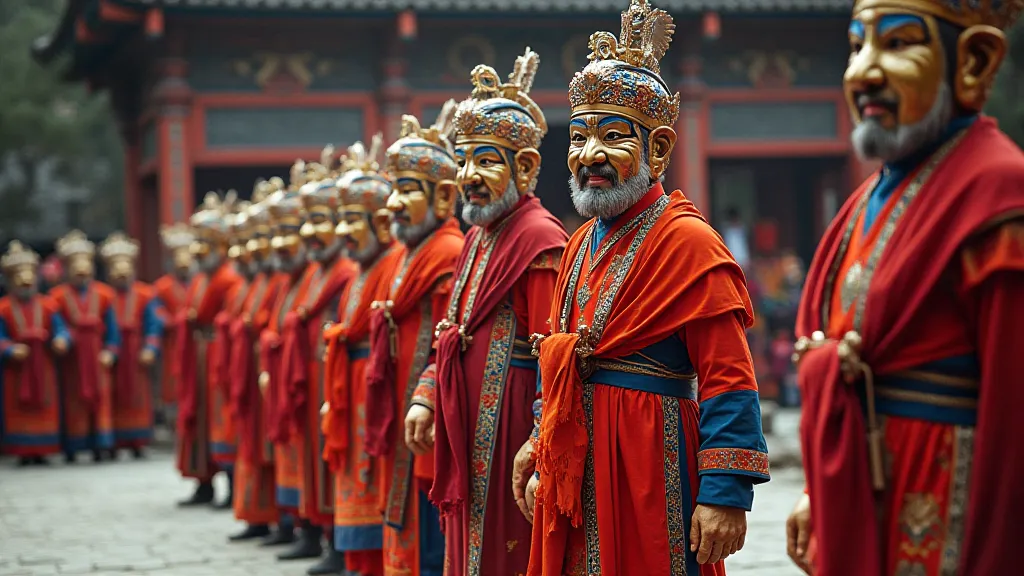 The continuing relevance of Tibetan opera masks highlights the enduring human need for ritual, performance, and symbolic representation. From warding off evil spirits to conveying complex moral lessons, these masks serve as a powerful reminder of the interconnectedness of art, culture, and spirituality. The careful selection of materials and the deliberate application of pigments isn't random; each element carries a layer of meaning, contributing to the overall narrative and impact of the performance. This attention to detail also finds echoes in other artistic traditions, such as the Romanian Mascarade Masks, each carrying its own rich history and symbolism. The echoes of ancient traditions resonate through centuries of art, influencing expression and identity.
The broader concept of using masks to create specific atmospheres and tell stories isn’t unique to Tibetan opera. The way narratives are interwoven with the physical form of the mask, allowing the performer to embody a character completely, represents a unique and powerful form of communication. The very act of covering one’s face, transforming oneself into another being, allows for a freedom of expression and a level of anonymity that can be both liberating and transformative. Understanding the nuances of these masked traditions provides valuable insights into the complexities of human culture and the enduring power of art to inspire, challenge, and connect us.
The traditions of mask making and performance are constantly evolving, influenced by contemporary trends and social changes. However, the core principles and symbolic meanings remain remarkably consistent, ensuring that these masks continue to be a source of pride and inspiration for generations to come. Their continued relevance demonstrates the profound impact of cultural heritage in a world that is increasingly interconnected, and it's a topic with parallels in traditions across the globe. The deliberate use of symbolism, the meticulous craftsmanship, and the enduring narratives—all combine to create a rich and powerful art form that continues to captivate and inspire audiences worldwide.
Furthermore, understanding the role of the artisan, the performer, and the audience is crucial to appreciating the full scope of Tibetan opera. The artisan's skill is not merely technical; it's a combination of artistic talent and spiritual understanding. The performer's ability to embody the character through gesture, voice, and movement is essential to bringing the mask to life. And the audience's appreciation for the artistry and symbolism contributes to the overall experience. The profound symbolism of masks echoes across numerous cultures, often tied to the preservation of storytelling traditions. Consider the way masks are used to safeguard and pass down narratives, even in contexts where direct communication is restricted. The enduring presence of mask-making demonstrates humanity’s persistent need for tangible representations of identity and experience.
The continuing relevance of Tibetan opera masks highlights the enduring human need for ritual, performance, and symbolic representation. From warding off evil spirits to conveying complex moral lessons, these masks serve as a powerful reminder of the interconnectedness of art, culture, and spirituality. The careful selection of materials and the deliberate application of pigments isn't random; each element carries a layer of meaning, contributing to the overall narrative and impact of the performance. This attention to detail also finds echoes in other artistic traditions, such as the Romanian Mascarade Masks, each carrying its own rich history and symbolism. The echoes of ancient traditions resonate through centuries of art, influencing expression and identity.
The broader concept of using masks to create specific atmospheres and tell stories isn’t unique to Tibetan opera. The way narratives are interwoven with the physical form of the mask, allowing the performer to embody a character completely, represents a unique and powerful form of communication. The very act of covering one’s face, transforming oneself into another being, allows for a freedom of expression and a level of anonymity that can be both liberating and transformative. Understanding the nuances of these masked traditions provides valuable insights into the complexities of human culture and the enduring power of art to inspire, challenge, and connect us.
The traditions of mask making and performance are constantly evolving, influenced by contemporary trends and social changes. However, the core principles and symbolic meanings remain remarkably consistent, ensuring that these masks continue to be a source of pride and inspiration for generations to come. Their continued relevance demonstrates the profound impact of cultural heritage in a world that is increasingly interconnected, and it's a topic with parallels in traditions across the globe. The deliberate use of symbolism, the meticulous craftsmanship, and the enduring narratives—all combine to create a rich and powerful art form that continues to captivate and inspire audiences worldwide.
Furthermore, understanding the role of the artisan, the performer, and the audience is crucial to appreciating the full scope of Tibetan opera. The artisan's skill is not merely technical; it's a combination of artistic talent and spiritual understanding. The performer's ability to embody the character through gesture, voice, and movement is essential to bringing the mask to life. And the audience's appreciation for the artistry and symbolism contributes to the overall experience. The profound symbolism of masks echoes across numerous cultures, often tied to the preservation of storytelling traditions. Consider the way masks are used to safeguard and pass down narratives, even in contexts where direct communication is restricted. The enduring presence of mask-making demonstrates humanity’s persistent need for tangible representations of identity and experience.




